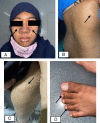De novo mutation of the TSC2 gene in patient with Tuberous Sclerosis Complex-Associated Neuropsychiatric Disorders (TAND) Phenotype: a case report
- PMID: 37228977
- PMCID: PMC10205250
- DOI: 10.1097/MS9.0000000000000489
De novo mutation of the TSC2 gene in patient with Tuberous Sclerosis Complex-Associated Neuropsychiatric Disorders (TAND) Phenotype: a case report
Abstract
Tuberous sclerosis complex (TSC) is a neurocutaneous disease caused by a mutation in the TSC1 or TSC2 gene. There are several neuropsychiatric manifestations associated with TSC known as TSC-associated neuropsychiatric disorder (TAND). This article concerns neuropsychiatric manifestations in children with the TSC2 gene mutation, with genetic analysis findings using whole-exome sequencing.
Case: A 17-year-old girl presented with TSC, absence and focal epilepsy, borderline intellectual functioning, organic psychosis, and renal angiomyolipoma. She was emotionally unstable and preoccupied with irrelevant fears. In the physical examination, we found multiple hypomelanotic maculae, angiofibroma, and a shagreen patch. The intellectual assessment result with the Wechsler Adult Intelligence Scale at 17 was borderline intellectual functioning. Brain MRI showed cortical and subcortical tubers in the parietal and occipital lobes. Whole-exome sequencing was conducted, and the result was a missense mutation in exon 39 of the TSC2 gene [NM_000548.5:c.5024C>T (NP_000539.2:p.Pro1675Leu)]. The Sanger sequencing of the patient's parents revealed no mutations in the TSC2 gene, confirming the patient's de novo mutation. The patient was given several antiepileptic and antipsychotic drugs.
Clinical discussion: Neuropsychiatric manifestation is a common phenotype in the TSC variant, and psychosis is one of the rare TAND symptoms in children.
Conclusions: The neuropsychiatric phenotype and genotype in TSC patients are rarely reported and evaluated. We reported a female child with epilepsy, borderline intellectual functioning, and organic psychosis associated with a de novo mutation of the TSC2 gene. Organic psychosis is a rare symptom of TAND which also manifested in our patient.
Keywords: case report; de novo missense mutation of TSC2 gene; tuberous sclerosis complex–associated neuropsychiatric disorders; whole-exome sequencing.
Copyright © 2023 the Author(s). Published by Wolters Kluwer Health, Inc.
Conflict of interest statement
The authors declare that they have no financial conflict of interest with regard to the content of this report.
Figures



Similar articles
-
TSC-associated neuropsychiatric disorders (TAND): findings from the TOSCA natural history study.Orphanet J Rare Dis. 2018 Sep 10;13(1):157. doi: 10.1186/s13023-018-0901-8. Orphanet J Rare Dis. 2018. PMID: 30201051 Free PMC article.
-
Neuropsychiatric profile in tuberous sclerosis complex patients with epilepsy.Front Pediatr. 2025 Jan 15;12:1436061. doi: 10.3389/fped.2024.1436061. eCollection 2024. Front Pediatr. 2025. PMID: 39882213 Free PMC article.
-
Sirolimus relieves seizures and neuropsychiatric symptoms via changes of microglial polarity in tuberous sclerosis complex model mice.Neuropharmacology. 2022 Nov 1;218:109203. doi: 10.1016/j.neuropharm.2022.109203. Epub 2022 Aug 2. Neuropharmacology. 2022. PMID: 35931213
-
Identification of TSC2 mosaic mutation limited to cortical tuber with TSC targeted sequencing: a case report and literature review.Childs Nerv Syst. 2021 Dec;37(12):3945-3949. doi: 10.1007/s00381-021-05059-1. Epub 2021 Jan 30. Childs Nerv Syst. 2021. PMID: 33517515 Review.
-
Tuberous sclerosis complex-associated neuropsychiatric disorders.Psychiatr Pol. 2022 May 3:1-20. doi: 10.12740/PP/OnlineFirst/146265. Online ahead of print. Psychiatr Pol. 2022. PMID: 36370437 Review. English, Polish.
Cited by
-
Novel Stop-Gain TSC2 Gene Mutation in an Indian Child of Tuberous Sclerosis Complex.Indian Dermatol Online J. 2024 May 20;15(4):657-659. doi: 10.4103/idoj.idoj_469_23. eCollection 2024 Jul-Aug. Indian Dermatol Online J. 2024. PMID: 39050051 Free PMC article. No abstract available.
References
-
- Ding Y, Zhou Y, Yu L, et al. . Correlation between epilepsy and genotype: a large retrospective tuberous sclerosis complex cohort. Seizure 2021;91:273–277. - PubMed
-
- Curatolo P, Moavero R, Roberto D, et al. . Genotype/phenotype correlations in tuberous sclerosis complex. Semin Pediatr Neurol 2015;22:259–273. - PubMed
-
- Toldo I, Brasson V, Miscioscia M, et al. . Tuberous sclerosis-associated neuropsychiatric disorders: a paediatric cohort study. Dev Med Child Neurol 2019;61:168–173. - PubMed
LinkOut - more resources
Full Text Sources
Miscellaneous
